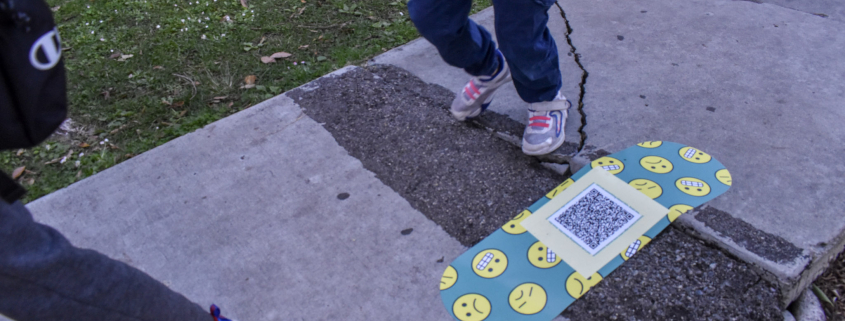Demonstrators put bandages on damaged sidewalks

University Park community members and USC students came together on the sidewalks near Norwood Street Elementary School Thursday morning to raise awareness about the long-standing issue of cracked and unsafe sidewalks.
The demonstration, Norwood Band Aid Activation, hosted by University Park Slow Jams, aimed to encourage community members to document poor infrastructure near Norwood Elementary. Participants placed large, colorful bandages on the sidewalks with QR codes linked to myLA311, Los Angeles’ service request system, to report the issues.
Public Matters, which founded UPSJ in 2019, leverages art and creativity for civic engagement. Using artistic approaches, UPSJ aims to raise awareness about traffic violence and poor infrastructure around five elementary schools in the University Park community.
“Part of what we want to try to do with our band aid activation is to try to get as many people as possible to report it,” said Reanne Estrada, co-principal and creative director of Public Matters. “And to see if we could have a giant tidal wave of requests to be like, ‘Come on, 50 years [of broken sidewalks] is enough already.’”
UPSJ works in collaboration with parents from the five elementary schools — Vermont Elementary School, John Mack Elementary School, Lenicia B. Weemes Elementary School, Foshay Learning Center and Norwood Elementary — and is also partnered with Los Angeles Walks, the Sol Price School of Public Policy, USC Kid Watch and USC University Relations. The project is funded in part by the USC Good Neighbors Campaign and USC Arts in Action.
“What we want to do,” Estrada said, “is to take the creative strategies or artistic media, different ways of working, and to bring them to bear on public participation — how we increase people’s participation and their sense of agency over the public realm and their civic processes and advocacy efforts.”
L.A. was the second deadliest city in the United States for pedestrians in 2020, according to data from the National Highway Traffic Safety Administration compiled by data journalist Henry Hoenig. Last year, 159 pedestrians and cyclists died in collisions with cars, the Los Angeles Times reported in January. Poor infrastructure in University Park — including unclear signage and poorly marked crosswalks — raised concerns that community members are at high risk of injury or death.
“It started in the 1920s,” said David Sloane, a professor of urban planning, policy, history and community health planning. “Urban planners and street engineers really tried to corral and manage pedestrians for the cars, and this is the beginning of auto-centric urbanism, where you focus on trying to make a place for the cars.”
In addition to the threat of unsafe driving, members of the Norwood Elementary community risk injury from tripping on cracked sidewalks. Lilia Garcia, a volunteer at Norwood Elementary and USC Kid Watch, said she fell on two separate occasions because of cracked sidewalks. The second time, Garcia said she “flew off” after tripping on the sidewalk.
“A teacher who saw me fall said, ‘Oh Miss Lili, you fly! My God!'” Garcia said, through an interpreter. “And, after I fell, I noticed that a lot of other children were falling, too.”
In the past, UPSJ led community members in “Slow Jams” — vibrant parades through crosswalks where participants carried large signs and drawings to remind drivers to slow down. UPSJ has also encouraged community members to conduct “walking audits” — where they would document broken sidewalks or other street hazards — as well as compiled resources into a digital story map and participated in an activity where members cross streets wearing large inflatable balls as commentary on the danger of crossing streets due to reckless driving.
“L.A. is horrible at fixing what I would call simple infrastructure, so the sidewalks have been bad for a really long time,” Sloane said. “Part of it is that, is it the responsibility of the school? Is it a responsibility of the L.A. [Department of Transportation]? Whenever you have a jurisdictional conflict, things are really hard to do in L.A.”
For now, UPSJ aims to put power back in the hands of the community to resolve safety issues through art and creativity.
“[We] now have a coalition of USC and the neighborhood, which is a really positive thing,” Sloane said. “The really great thing about it is, you have the heft of USC as a major employer, and you have the enthusiasm and the commitment of the neighborhood.”

